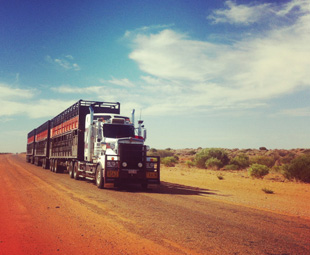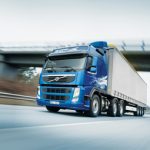Australian vehicle anomalies

Peculiar-looking vehicles roam the streets of Australia. AIMEE SHAW takes a look “down under” to explore the interesting world of road trains and double-steer refuse trucks.
Imagine transporting 100 bulls across 320 km of the Australian Outback. The first modern road train was created by Kurt Johannsen using an American army tank-retrieval tractor left behind after the Second World War.
Johannsen was challenged and inspired by the South Australian government trains (which use wagons on pivots) to develop trailers with self-steering axles.
Road trains or “truck trains” are unusual-looking vehicles resembling a traditional railway train, and are used to transport goods across the remote areas of the Australian Outback.
These road trains travel with livestock, grains, fuel, ore and construction materials, which are stacked densely in volume and weight. For this reason, road trains are restricted to the northern Outback with measurements that stretch up to 53,5 m in length.
 Australian road trains are designed specifically for the vastness of the Outback, which consists of one-lane roads. Roads and trains have been improved over the years, but hazards are posed by large stretches of barren land. For this reason, drivers need to plan well and be equipped with the relevant knowledge and supplies.
Australian road trains are designed specifically for the vastness of the Outback, which consists of one-lane roads. Roads and trains have been improved over the years, but hazards are posed by large stretches of barren land. For this reason, drivers need to plan well and be equipped with the relevant knowledge and supplies.
All modern road trains are equipped with radio devices for drivers to communicate with a base station. Drivers notify the base station of departure and expected arrival times for each trip.
In addition, road trains come with sleeper boxes, lockers and air-conditioning for additional safety and comfort. Generally road trains travel at night. However, they do still operate and share the road with “regular” traffic during the day.
According to the Australian Road Train Association, drivers should not be on the road for longer than 14 hours per day. Added precautions should be taken for operations requiring additional space to pick up speed and to slow down, or when attempting to turn.
Carstuff host Ben Bowlin and co-host Scott Benjamin describe road trains as “time, resource and energy saving”. An off-shoot of HowStuffWorks.com, Carstuff is a website featuring podcasts discussing topics that relate to the automotive industry.
Benjamin says the largest road trains are found in Australia and have nine major variations. The largest design is the “body and six”, which is banned from public roads and is able to operate only on private property.
 The driver will need a special permit to operate this type of road train and relevant knowledge to change the tyres if necessary, which can be risky and time-consuming.
The driver will need a special permit to operate this type of road train and relevant knowledge to change the tyres if necessary, which can be risky and time-consuming.
In urban areas, drivers may need to unhook individual carriers (if the road train is too long) and, once the remaining trailers have been delivered, return at a later stage to hook them up and transport them through the urban area.
Australia has the largest usage of road trains with an average weight of between 80 and 120 t. The maximum weight may not exceed 200 t. In addition, drivers need to be aware of licensing rules and regulations and when it is “seasonal” to operate on public roads. Road trains are considered cost-efficient and are integral for the regular supply of goods to communities in the Outback.
In the urban areas of Australia, Mercedez-Benz Australia is proving its mettle in the waste industry, with the arrival of the new dual-steer refuse truck. In a previous article, written by Frank Beeton for Global Focus March, he says: “One will notice that these trucks have steering wheels on both sides of the cab.”
The Australian waste industry utilises the “one-man-operated system of wheelie-bin collection”. Citizens are required to place their bins on a painted mark one metre from the kerbside, with 300 mm space between bins and other objects.
This is the first time this specialised version of the Mercedes-Benz Econic dual-steer truck has made its way to the Australian market, although dual-steer Iveco ACCO and Dennis Eagle trucks are also available.
 The Mercedes-Benz Econic dual-control refuse truck was originally designed in Wörth, Germany, and introduced to the Australian market at the 2012 International Truck, Trailer and Equipment Show in Melbourne.
The Mercedes-Benz Econic dual-control refuse truck was originally designed in Wörth, Germany, and introduced to the Australian market at the 2012 International Truck, Trailer and Equipment Show in Melbourne.
It evolved from a single-steer model to a dual-control system, specifically to support refuse collectors in controlling their vehicle from the side closest to the kerb.
“Refuse compactor vehicles are equipped with side-loading equipment to lift the bin and tip its contents into the on-board hopper,” says Beeton. “After this procedure, the bin is replaced back to where it was taken from.”
Andrew Assimo, sales manager for Mercedez-Benz trucks, says: “The dual-control Econic has the full suite of safety and environmental features, including the Euro-6 engine, a low-entry cab design and the additional side-loader system for increased visibility.” These trucks have been designed with computerised technology to aid the aspect of safe operation.
The Electronic Stability Program is designed to improve the vehicle’s stability by detecting and reducing loss of traction. Additional safety features include the Electronic Braking System and the Anti-lock Braking System.
In addition, the Econic uses a 7,7-litre diesel engine with power outputs of 223 kW (299 hp) to meet Euro-6 emission standards. This engine produces reduced emissions of “up to 90 percent compared to the Euro-5 engine”.
The cabin is designed to comply with the Economic Commission for Europe (ECE-R29) crash test regulations and features a panoramic windscreen for constricted areas, with comfortable driver seats and air suspension on all axles for drive control and braking.
It is linked to a six-speed Allison fully automatic transmission system to lower engine speeds in support of energy-efficiency and fuel saving.
“We are excited to introduce a dual-control version which, we think, ticks all the boxes for Australian waste-collection operators,” says Assimo.
When visiting Australia, don’t be alarmed if you see an automated refuse truck with twin-steering, picking up and replacing bins from the side of the road, or if a road train, with six trailers, tries to overtake another vehicle.
These distinctive and unusual-looking vehicles have gradually made their way onto Australian roads as tangible proof of innovation to support and adapt to the unique operating conditions of this country.
Published by
Focus on Transport
focusmagsa




